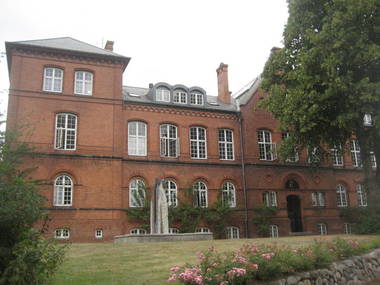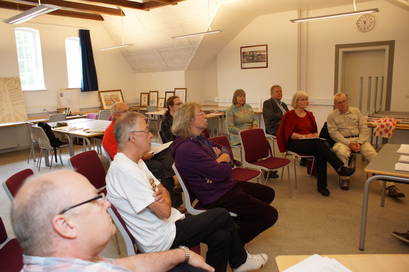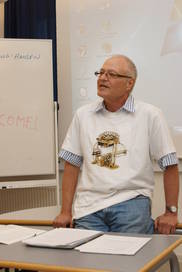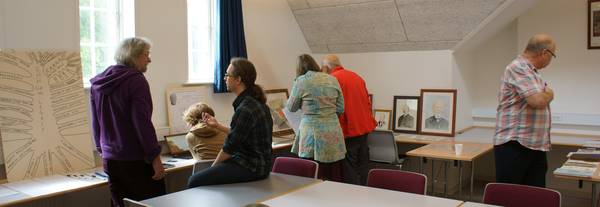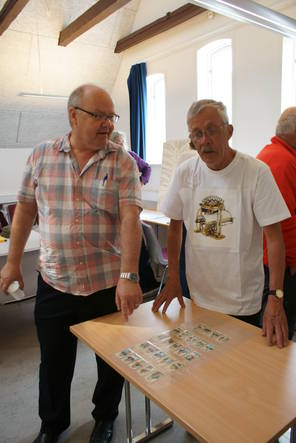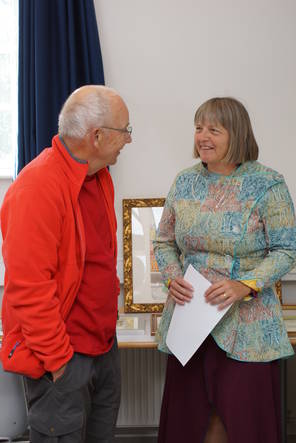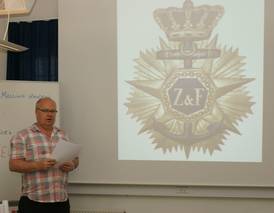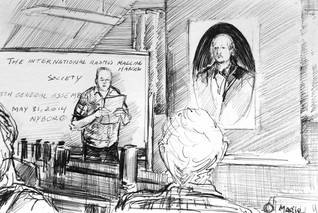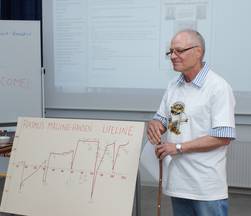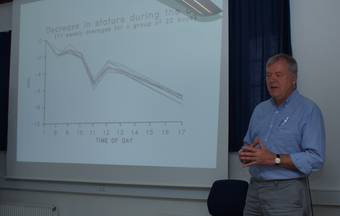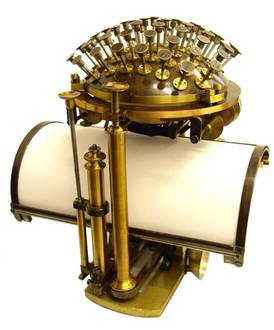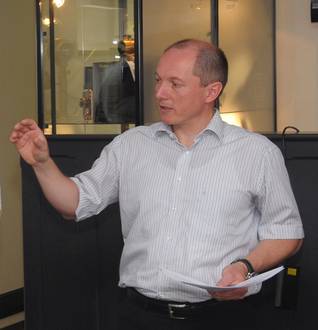Report from the 5th General Assembly, Nyborg, Denmark, 31st of May, 2014.
Welcoming Remarks.
The President, Jørgen Malling Christensen, welcomed members and friends to the meeting and underlined that the building and the site is historical ground for our society: Malling-Hansen suggested the establishment of the institution when he was secretary of the 1888 government commission for planning of special education in Denmark. Malling-Hansen even planned the layout and details of the building and its interior. He would have been proud to see how well preserved the building is to this day! The building was inaugurated on Sep 7, 1891 - one year after Malling-Hansen passed away.
Jørgen paid tribute to the present VUC-centre and its principal Anders Munch Hansen for graciously letting us use the premises and to the caretaker Jan Lykkegaard Mouritzen who had spent a large part of his otherwise free Saturday to assist the members and prepare the meeting. The society is extremely grateful to the VUC-centre and its staff, and after the meeting Jørgen presented Anders and Jan each with a beautiful signed lithography of the writing ball and of Malling-Hansen with some details of one of his patents as a token of our appreciation.
The President extended a special welcome to an old friend of the Society: Kim Fleischer Michaelsen, professor of paediatric nutrition at the National Hospital of Denmark and advisor to the National Board of Health on infant and paediatric nutrition. Furthermore, Kim is chairman of a research group: Paediatric and International Nutrition at the Department of Human Nutrition. His interest in Malling-Hansen’s physiological research goes back to the beginning of the 1990s and we were very pleased to welcome Kim and looked forward to his presentation.
Secretary.
Sverre Avnskog was elected secretary of the meeting.
Invitations; Reports.
It was noted that the GA had been called in January 2014, hence with adequate time for members to prepare. Apart from members and friends of the Society, invitation had also been sent to the seven Danish museums that are known to own writing balls, as well as to the local newspaper of Nyborg.
Two of the seven board members were unfortunately unable to attend – Paul Bech and Uwe Breker.
One of the founding members of the Society, Carsten E. Noe, was celebrating his 50 year anniversary on the very day of our meeting and therefore could not attend. The meeting sent him good wishes and congratulations!
The report of the previous GA in 2012 was approved.
Important Events Since the Meeting in 2012.
Jørgen Malling reported and said that our Society is essentially an ongoing historical research project. The period from May 2012 the research is characterised by a substantial expansion of the amount of documents and illustrations on the website, all of them a result of deeper and broader research efforts. We have more than 4000 illustrations and a text mass corresponding to several thousand A4-pages. This is, in itself, a considerable contribution to an important piece of cultural and technical history of Denmark.
One of the goals of the Society is to set up a museum exhibition of Malling-Hansen’s life and work, and to that effect Christian has been in contact with the Museum of Science and Technology in Helsingør, while Jørgen has had a dialogue with the Museum of Maribo,as well as with the Maribo Tourist Office. So far, however, no museum has had the capacity – or the interest – to accept our offer of cooperation and assistance. Danish museums have very scarce resources in terms of manpower and finances. One of the effects of this is that according to official figures from the government, merely 10 % of the 21 million artefacts held by the major Danish museums have been registered so far; 90 % are stored in archives and cellars and unregistered. This is on the one hand depressing, but it also opens opportunities to make exciting finds in future – perhaps additional writing balls and the takygraf?
One such discovery is a writing ball in Athens, Greece, previously owned by the Greek king Georg I (1845-1913), a Danish prince and son of King Christian 9 of Denmark. He knew Rasmus Malling-Hansen and had, as a young prince, visited the school at Kastelsvej together with his family. We have not yet found out where the said writing ball is kept, but we do have a photo of the item on the desk that belonged to the king. It may be in the old parliament building or in a museum related to the royal family.
Jørgen Malling mentioned that he has had very good cooperation with the Panum Institute, the Clinic for Medical Genetics, Department of Cellular and Molecular Medicine, whose head, Professor Marie-Louise Bisgaard has given our Society VIP treatment! Her department has taken over the archives of the former Danish Anthropological Committee, and we have gained access to the inner archives in search of Malling-Hansen’s personal notes concerning his physiological research. We know for certain that such personal notebooks were handed over to the Committe in 1911. They even paid for a consultant to spend a full week searching for these documents, but unfortunately they were not found; however, they did find confirmation that the personal notes have once been in the archive, and Sverre Avnskog also mentioned that he had had contact with the institute earlier and go the same information. Sverre could also provide the information that our old contact at the Museum of the History of the Deaf, Jan William Rasmussen, had told him that the Society of the History of the Deaf had had in their possession several hundred of notebooks in various colours and full of notes of the results from Malling-Hansen’s measurements and weighings at the school. We shall now continue our search and turn to the Danish National Archive to which the notebooks have, possibly, been transferred.
This is also related to the interesting fact that in 2012 the entire archive of the Danish National Association for the Deaf, which was previously kept in the basement of the Royal Institute for the Deaf-Mute, has now been transferred to the National Archive – 66 shelve meters of documents. One of our many future tasks will be to access this material as soon as it has been registered and organised by the National Archive.
We have also been given exclusive access to the archives of the Danish Art Museum Ordrupgaard, former home of Wilhelm Hansen, a wealthy art patron and one of the most important persons in the history of the language of Volapyk in Denmark . In 2013 Jørgen Malling was given complete access to their private archives, but unfortunately there was no evidence of any correspondence between Malling-Hansen and Wilhelm Hansen.
In 2013 a German publishing company made a reprint of “Fragment III.A.”, Malling-Hansen’s major report on his physiological research, published in German and Danish in 1886. This is a very interesting and pleasing event, showing that there is still an interest in his research! The Society has bought the re-print, and it is now in the archive (with the President).
Jørgen Malling reported that sadly one of our founding members, and also the first honorary member of our Society, Count Adam Knuth, passed away in December 2013, 80 years old. Our Society sent a wreath to his funeral and we published a laudatory obituary on our website. We do hope that his son Christoffer, who was also one of the founding members, will remain in our Society and we hope to continue the very good cooperation we have enjoyed with the family ever since 2006.
After this general overview of some of the highlights of developments and events since the last GA, Jørgen gave the floor to our webmaster Sverre for an update about our website.
Sverre Avnskog showed on the large screen how to move around the very large website and how to find the information in head chapters and sections. New and previously unknown Malling-Hansen documents are continuously being discovered, and, in particular, the section about Malling-Hansen’s scientific, physiological research has grown and expanded by leaps and bounds. The first two of his “Fragments” are published in extenso, and the third one is explained and commented upon. A large number of articles from newspapers and journals of the 1880s have been transcribed and published with footnotes. Of particular importance is the Swedish medical scientist and doctor (cardiologist) Gustav Nylin, who chose for his doctoral thesis in 1929 the same field of research as Malling-Hansen. He followed in Malling-Hansen’s footsteps in terms of methodology and focus and his results of several years on measurements of several thousand of Swedish school-children largely confirmed Malling-Hansen’s results. Two large documents by Nylin have been published on the website, and more is to appear.
The President, Jørgen Malling Christensen, has produced a large number of transcribed documents during the last two years, and the procedure is that he sends the transcripted and foot-noted documents to Sverre, who will then scan the documents and publish them together with relevant illustrations. By far the most important source of illustrations is the Royal Library in Copenhagen, who has given us permission to use their illustrations free of charge, since we are a non-commercial society.
Financial Report.
Our treasurer, Lars Mathiesen, provided the report on finances and membership. We are a small society with few members, and this is also mirrored in our financial situation. The annual fee is DKK 300 (approx 40 Euro), but unfortunately it has proven to be difficult to get all members to pay. After some discussion pro et con it was, however, agreed that no members will be taken off the membership list, even if they omit to pay the fee, but that Lars will send a polite reminder to such members.
We would like to appeal to all members to pay up; the fee is small, and we do need money for some items, e.g. postage, the website and stationery. As it is now, the few members who are very active not only spend much time for the Society but also pay for many expenses from their own pocket.
The meeting agreed to keep the membership fee at the same level.
It appears that the fee we are paying for the maintenance of our website is somewhat higher than what other companies in the market are offering, and it was decided that Sverre will contact the owner of the web hotel with a request for a reduction.
Re-election of the Board.
All seven members of the board: Christian Barnholdt, Dieter Eberwein, Jørgen Malling Christensen, Lars Mathiesen, Paul Bech, Sverre Avnskog and Uwe Breker were unanimously re-elected to continue on the board.
The board members met immediately after the GA, and between themselves decided that the board members continue in their present position, as follows:
Jørgen Malling Christensen, President; archivist, research coordinator, translator
Sverrre Avnskog, Vice-President and web-master
Dieter Eberwein, Vice-President
Christian Barnholdt, Honorary Member
Lars Mathiesen, Treasurer
Paul Bech, Member
Uwe Breker, member
All Other Business.
Christian Barnholdt and Jørgen Malling Christensen had two exciting pieces of news:
Our Society has been approached by descendents of Erik Ritzau, offering us to make a bid for the famous painting by Malthe Odin Engelstedt of the four friends playing l’hombre – Erik Ritzau, Johannes Kaper, Gustav Feilberg and Rasmus Malling-Hansen. In addition: the table they are using for the card game and which the family wishes be kept together with the painting. After much discussion at the meeting and also the following day, a small group of members, blood-related to Malling-Hansen (Lars, Jacob, Elsebet and Jørgen) decided to make a bid for the two items, using their private funds. This was done, but the bid was not accepted by the family and the issue is open for further initiatives.
The other exciting piece of news was that according to the Director of the Museum of Science and Technology, Helsingør, Malling-Hansen’s writing ball will appear in 2015 as one of five stamps depicting famous Danish inventions! We hope that this will be born out and see it as a fruit of our hard work ever since 2006 aiming at making Malling-Hansen and his inventions and other important contributions for mankind better known.
This concluded the first part of the fifth General Assembly. The meeting went for lunch and lectures/presentations were to follow throughout the afternoon, crowned by a celebratory drink onboard the good ship “Lola” and dinner together at the adjacent harbour restaurant.
The following day, some of the members went on a sightseeing tour of Nyborg, savouring some of the rich treasures of this once very important town, “in the heart of Denmark”.
Afternoon Session – Presentations and Lectures.
Sverre Avnskog: Malling-Hansen as a Freemason
Rasmus Malling-Hansen was adopted as a freemason member in 1877 by the lodge of Zorobabel and Frederik of the Crowned Hope. He remained a member until his death, gradually rising through the ranks and achieving the 9th rank, at the very top of the ladder. In 1888 he was elected Speaker of the lodge, implying that he would give a speech at the meetings or, alternatively, select another person to give a speech of interest to the members. Sverre showed illustrations on a large screen and had found documentation from literature about the lodge and the lodge building in Klerkegade, where Malling-Hansen spent his very last evening in life. He died from a stroke on his way home after the meeting on a late Saturday evening in the fall of 1890. It was very interesting for the society members and friends to see old photographs from the interior of the lodge building in Klerkegade, showing large mural paintings with symbols of various kinds, among them a David Star. Sverre also showed portraits of Malling-Hansen’s closest friends in the last years of his life, all of them lodge members.
Kim Fleischer Michaelsen
The next highlight of the meeting was the presentation by the Danish paediatrician and nutritionist of world re-known, Kim Fleischer Michaelsen. As far back as in 1993 he expressed keen interest in Malling-Hansen’s physiological research into periodicity in children’s development of weight and height. At that time Christian Barnholdt assisted Kim to prepare his funding application from the Carlsberg Foundation, aiming at testing Malling-Hansen’s results and theories. Unfortunately the application was turned down. However, now Kim is back as a friend of our Society and intends to resume this important and exciting area of research. In his presentation Kim highlighted some of the contemporary and more recent research in the same area as that of Malling-Hansen and mentioned that his (Kim’s) focus is on the possible influence of the moon in relation to growth and weight development of children. He had not found this issue to have been specifically addressed by RMH but it would be of great interest if the moon cycle could be identified as having had an influence on the results documented by RMH. As part of his preparations for his presentation Kim had read Malling-Hansen’s last publication, Fragment III A., and said that he found Malling-Hansen’s theories difficult to penetrate and understand. However, he admitted that this may be because the theories are so advanced and sophisticated that they are difficult to grasp for anybody else than the author. Generally speaking Kim is more interested in the purely professional and tangible aspects of Malling-Hansen’s research and less interested in his explanatory models or hypotheses about the causal factors behind human and biological growth on earth, - RMH was, of course, a highly religious man, and some of his explanations and theories bear a certain metaphysical character.
Jørgen Malling Christensen: Malling-Hansen’s Life Curve.
The next speaker was the President of the Society, who presented a very interesting life curve, or life line, depicting Malling-Hansen’s life, where the vertical axis represented the degree of happiness and fulfilment in life, whereas the horizontal line showed the years spanning RMH’s life, from 1835 until 1890. Major positive and negative events were registered and these events were plotted into a red line, showing ups and downs in his life. The curve is at a particular maximum in 1865 – “annus mirabilis”! – when RMH was appointed principal of the Royal Institute for the Deaf-Mute; he also married his fiancée Cathrine Georgia Heiberg; he finished his theological studies with an excellent degree from the University of Copenhagen; and he was busy at work with his first ideas and designs concerning the writing ball. The following 10 years are presumably the happiest and most successful period of his life – the couple had seven daughters, Malling-Hansen experienced great success with his inventions, and he quickly acquired an outstanding reputation as a brilliant teacher of the deaf-mute, a gifted preacher in sign language, a skilled and dedicated principal and an influential authority – at least in Scandinavia – in the area of special education. The bottom point of his life was probably in the autumn of 1876 when his first wife died while giving birth as well as the baby twin girls she was about to have. However, from that level of despair the curve of life quality rose again and achieved a new point of high when he re-married in 1880 with Anna Steenstrup. He also entered a very active and successful period in terms of his scientific, physiological research as well as a reformer of the Danish model for the teaching of deaf and deaf-mute children of various categories.
Dieter Eberwein:
The last speaker of the afternoon was Dieter Eberwein, one of our two vice-presidents, and a person who has acquired very deep knowledge and insight into the structural and functional details of the writing ball. Dieter has restored several writing balls, among them the writing ball that belonged to the world famous philosopher Friedrich Nietzsche. On the screen Dieter showed how he had also analysed all known texts written by Nietzsche with the writing ball, and Dieter was actually able to establish exactly where on the inked ribbon each letter or poem had been typed. This was possible by analysing the structure of the inked ribbon and compare it with the specific details of the imprints of each alphabetic letter on the paper. A thickening of the ribbon tissue would be mirrored in a thickening of the alphabetic letter (type) produced by that particular part of the ribbon. And by analysing which letters of the alphabet that were imprinted more strongly, respectively those that were weaker, Dieter was also able to produce a kind of “hand imprint”, which was particular for Friedrich Nietzsche. He was able to show on the screen a picture illustrating this “hand imprint”, and it could be clearly seen that the letters typed with the right hand left a much clearer and stronger imprint than those produced by the left hand, which was partially paralysed at the time Nietzsche used his typewriter (writing ball). Dieter could also show illustrations documenting the damages caused to Nietzsche’s writing ball during the transport from Denmark to Genoa, northern Italy. Unfortunately no one was able to repair those damages, and this led a few people to the conclusion that the writing ball was a second class invention. However, Nietzsche’s problems were due to transport damages in addition to further damage being inflicted when attempts were made to repair it, among them a bicycle repairer.
24.06.2014
Jørgen Malling Christensen
and
Sverre Avnskog


